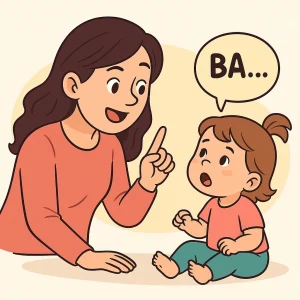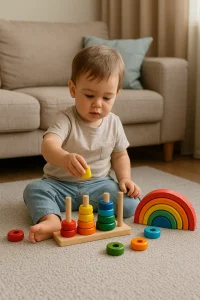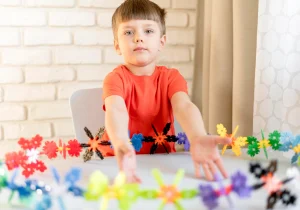Effective Autism Toilet Training Tips for Parents
Last Updated: April 4, 2025
Toilet training can be particularly challenging for children with autism, who may struggle with sensory sensitivities and changes in routine. That’s why Autism Toilet Training Tips are so important—they offer simple, effective ways to support your child’s unique needs. At Wellness Hub, we’re here to help with practical guidance and tailored resources to make this journey smoother. With the right approach, toilet training can become a positive milestone your child achieves with confidence and comfort.
Why Toilet Training Can Be Challenging for Children with Autism
Toilet training is a complex process that involves a series of nuanced steps, each demanding a certain level of sensory and communication coordination. For children with Autism Spectrum Disorder, who often experience heightened sensory sensitivities, this can create significant hurdles. The feeling of different textures, such as toilet paper or flushing sounds, can be overwhelming. This sensory overload can lead to anxiety or avoidance behaviors, which complicate the learning process associated with toilet training.
Communication barriers add another layer of complexity. Many children on the autism spectrum find it difficult to express their needs or understand the cues associated with toileting. For instance, recognizing the bodily sensations that signal a need to use the restroom, or understanding and following the steps involved in using the toilet, can be challenging. This often means that conventional potty training strategies may not always be effective without adaptations.
Preparing for Toilet Training
Toilet training is a big step for any child, but when your child has autism, knowing when to start and how to prepare the environment can make a significant difference. Here’s how you can set the stage for a successful toilet training experience.
Choosing the Right Time to Start
Starting toilet training at the right time is crucial, especially for children with autism. Unlike typical developmental timelines, the “best age to start toilet training for autism” varies widely because it depends more on readiness cues than on age. Look for signs that your child is ready to begin this new chapter. These signs might include showing discomfort with soiled diapers, remaining dry for longer periods, or showing interest when others use the bathroom. Recognizing these cues in your child can indicate that it’s time to start introducing toilet training in a gentle and supportive way.
Creating a Conducive Environment
Making the bathroom autism-friendly is essential to ensure a smooth toilet training process. Here are some practical tips to create a supportive bathroom environment:
- Visual Aids: Use simple, clear visual aids like picture schedules or sequence cards to outline the steps involved in using the toilet. These can help demystify the process and provide predictable structure.
- Sensory Considerations: If your child is sensitive to sounds, consider a quieter toilet flush or provide a calming toy to hold during flushing. For sensitivities to light, softer, non-flickering lights can make the bathroom more comforting.
- Safety and Accessibility: Ensure that everything your child needs is easily accessible. This might include a smaller toilet seat, a stool for reaching the sink, and non-slip mats to prevent accidents.
- Personalization: Decorate the space with elements that your child likes, such as favorite colors or themes. This personal touch can make the bathroom a more inviting place for your child.
Essential Toilet Training Techniques for Autism
Successfully toilet training a child with autism often requires specific strategies that cater to their unique needs. Two of the most effective techniques involve the use of visual schedules and behavioral reinforcement. Here’s how these methods can be implemented to support your child’s toilet training journey.
Using Visual Schedules
Visual schedules are an excellent tool for breaking down the toilet training process into manageable, predictable steps. These aids help children with autism understand what’s expected of them, reducing anxiety around the unfamiliar.
How to Create and Use Visual Schedules:
- Identify Key Steps: Break down the toilet routine into simple steps, such as going to the bathroom, pulling down pants, using the toilet, flushing, washing hands, and returning to play or other activities.
- Choose Appropriate Symbols: Use clear, understandable pictures or icons that represent each step of the process. Ensure these visuals are recognizable to your child.
- Arrange Sequentially: Place the images in a sequence that matches the actual routine. This can be on a single sheet or a series of cards that your child can manipulate.
- Accessible Placement: Hang the visual schedule at your child’s eye level in the bathroom where it’s easily seen during the routine.
- Routine Reinforcement: Regularly refer to the schedule each time the child goes to the bathroom to reinforce the routine and expectations.
Using visual schedules not only promotes independence but also helps embed the toilet training routine into your child’s daily habits, making the process smoother and more predictable.
Behavioral Reinforcement Techniques
Positive reinforcement is a powerful strategy in autism education, and toilet training is no exception. It involves rewarding desired behaviors to encourage their recurrence.
Effective Positive Reinforcement Strategies:
- Immediate Rewards: Provide a small reward immediately after your child completes a step or the entire routine. This could be a sticker, a favorite snack, or a few minutes with a beloved toy.
- Consistency is Key: The key to reinforcement is consistency. Ensure rewards are given consistently for the same behaviors to strengthen the learning connection.
- Verbal Praise: Accompany rewards with enthusiastic verbal praise. Simple phrases like “Great job going to the potty!” can reinforce the behavior and boost your child’s confidence.
- Gradual Phase-Out: As your child becomes more consistent, gradually reduce the frequency of tangible rewards and focus more on verbal praise and intrinsic rewards like pride in their accomplishments.
Read more: Using Positive Reinforcement to Enhance Your Child’s Focus
Overcoming Common Obstacles in Toilet Training
Toilet training can present various challenges, particularly when teaching children with autism who might be nonverbal or have unique learning needs. Understanding how to effectively handle accidents and adjust strategies for nonverbal children can make a significant difference in creating a positive training experience.
Dealing with Accidents
Accidents are a normal part of the toilet training process, but they can be particularly discouraging both for the child and the parents. The key is to handle these situations with patience and positivity.
Tips for Handling Accidents Without Discouragement:
- Stay Calm: React calmly and reassuringly. Showing frustration or disappointment can create anxiety, making future training sessions more stressful for your child.
- Quick Cleanup: Have a routine for quickly and efficiently cleaning up after accidents. This reduces discomfort for the child and minimizes stress.
- Encouraging Words: Use encouraging language like, “It’s okay, we’ll try again next time. You’re doing great!” This supports a positive mindset and resilience.
- Review the Schedule: If accidents are frequent, revisit the visual schedule or routine to ensure it’s clear and understandable for your child.
- Consistent Routine: Maintain a regular schedule for toilet visits to minimize accidents. Predictability can greatly aid children with autism.
Handling accidents with empathy and understanding reinforces learning without pressure, ensuring that toilet training remains a positive process.
Adjusting Strategies for Nonverbal Children
Toilet training nonverbal or minimally verbal children with autism requires specific adjustments to communication strategies to ensure they understand and can follow the training process.
Effective Communication Strategies:
- Use of Visuals: Enhance communication through visual aids such as pictures or icons that illustrate the steps involved in toilet use. This can help bridge the communication gap.
- Gesture-Based Communication: Incorporate simple signs or gestures that the child can use to indicate their need to use the bathroom.
- Physical Prompts: Gently guiding your child through the motions of going to the toilet can help them understand what is expected without needing verbal instructions.
- Positive Reinforcement: Utilize non-verbal rewards such as clapping, smiling, or giving a thumbs-up to provide feedback and encouragement.
- Customize the Approach: Tailor the training methods to fit your child’s specific sensory preferences and learning capabilities, such as preferred textures or colors for toilet seats or training pants.
Know more our article on Understanding and Supporting Nonverbal Children with Autism
Conclusion
Toilet training a child with autism is a journey filled with learning and growth. Remember, patience and persistence are your best tools. Use visual aids, adapt the environment, and embrace positive reinforcement to support your child’s unique needs. Accidents are part of the process—handle them with care and keep encouraging your child. At Wellness Hub, we’re here to help. Our resources and expert advice are tailored to make toilet training smoother and more effective for your family. Discover more strategies and support on our Toilet Training Resource Page. Together, we can turn challenges into achievements.
Frequently Asked Questions:
1. What is the best age to start toilet training for a child with autism?
There’s no one-size-fits-all answer; readiness varies by child. Look for signs like staying dry for longer periods or showing curiosity about the toilet. Begin training when these signs appear consistently.
2. How can I make the bathroom more comfortable for my autistic child?
Create a calming environment by using visual schedules, soft lighting, and accessible features. Ensure safety with non-slip mats and use familiar themes to make the space welcoming.
3. What are visual schedules and how do they help in toilet training?
Visual schedules use pictures to outline each step of the toilet routine, helping children with autism understand and follow the process independently, thereby reducing anxiety and confusion.
4. How should I respond to toilet training accidents?
Approach accidents with calm and reassurance. Quickly clean up and gently encourage your child to try again, emphasizing that accidents are a normal part of learning.
5. Can you give tips for toilet training a nonverbal autistic child?
Use clear visual cues and physical guidance to communicate the process. Introduce consistent signs or gestures to help your child express their bathroom needs without verbal communication.
6. What type of positive reinforcement works best for autistic children during toilet training?
Immediate, consistent rewards such as favorite treats or extra playtime work well. Combine these with enthusiastic praise to reinforce successful bathroom visits.
7. How often should I take my child to the toilet when starting training?
Start with regular intervals, like every two hours, to establish a routine. Adjust frequency based on your child’s progress and comfort level.
8. What should I do if my child is scared of flushing the toilet?
Help your child gradually get used to the sound and action of flushing. Demonstrate it yourself first, then encourage them to try flushing from a distance they’re comfortable with, slowly moving closer.
9. How long does toilet training typically take for a child with autism?
The duration varies significantly based on individual needs and developmental pace. Consistent practice and patience are essential for success, and it might take longer than it does for typically developing children.
10. Where can I find more resources on autism-friendly toilet training techniques?
Visit Wellness Hub’s Toilet Training Resource Page for detailed guides and expert advice tailored to assist parents of children with autism in managing and succeeding in toilet training.
About the Author:
Shilpa Deshpande
Shilpa Deshpande is a skilled speech-language pathologist with over 14 years of experience. Fluent in Kannada, Telugu, Hindi, and English, she specializes in parent counseling, speech sound disorders, fluency assessment, and speech-language evaluations. Shilpa excels at working with children with developmental disorders, offering creative and effective therapy programs. Currently, at Wellness Hub, she holds a BASLP degree and is registered with the RCI. Her patience, ambition, and dedication make her a trusted expert in her field.
Book your Free Consultation Today
Parent/Caregiver Info:
Client’s Details:
* Error Message








